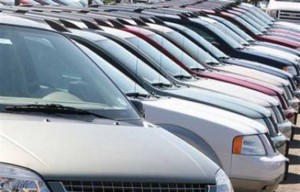
Analysts warn that creeping incentives, increased leasing and lower credit scores for buyers are potential threats to automaker profits.
Car makers are expected to report strong sales again when the numbers for March are posted even as concerns about the industry’s future prospects increase.
In addition, analysts are now predicting that new-vehicle sales will match or surpass those of 2015, when the industry set an all-time sales record
The concerns, however, revolve around the steady growth of leasing, which is reaching an all-time high, and the declining credit scores of buyers, according to a presentation J.D. Power & Associates presented this week at the National Automobile Dealers Conference in Las Vegas.
“Following an exceptional performance in 2015 with strong sales and record average price per vehicle sold, the U.S. automobile market must adopt a more disciplined approach to maintain long term health for the industry,” Power warned in its annual NADA briefing.
Incentive spending on new vehicles has climbed rapidly in the past year and is trending toward recession-era levels for the industry as a whole and has already exceeded recession-era levels on cars, Power noted. Other analysts also have noted that sluggish sales of passenger cars, which have been eclipsed by the trucks and SUVs, have prompted carmakers to increase incentives on various car models.
Inventories of passenger cars have also crept up, although carmakers, such as Fiat Chrysler and General Motors, have taken steps to reduce number of unsold models sitting on dealer lots by cutting car production.
J.D. Power noted in the analysis it presented that while overall industry retail sales are expected to grow by 300,000 to 14.5 million units in 2016, the growth is being delivered through actions that pose meaningful risks to the long-term health of the industry. Those actions include elevated incentive spending, increased use of extended loan terms, rising loan-to-value ratios and record levels of leasing.
(Get a first look at the new Tesla 3: the EV maker’s big bet. For more, Click Here.)
“Overall, auto sales figures continue to post strong results, but when you peel back just one layer beneath the surface, some worrisome trends are taking hold,” said Thomas King, vice president of Power Information Network at J.D. Power.
“Chief among the trends is the fact that first quarter sales incentives averaged 9.6% of (manufacturers suggested retail price,) a 70 basis-point increase from last year and are trending toward levels observed at the height of the recession.
“The increased spending, which is due primarily to manufacturers trying to offset a shift in demand from cars to trucks and SUVs, has the potential to reduce future resale value. Significant declines in the value of used cars would disrupt consumers’ ability to buy new vehicles (due to lower trade-in values), while vehicle manufacturers and lenders would have to deal with exposure on their lease portfolios if off-lease vehicles fail to achieve their expected resale value.” he added.
King’s warnings aren’t exactly a surprise the concerns over rising incentives, longer-term loans and the growth of leasing, which seems to present a permanent shift away from the purchase model that has prevailed for decades have been in the air for the past year.
(Click Here for details about FCA’s possible addition of a second midsize truck.)
Mike Jackson, Auto Nation’s chief executive, issued a similar warning during the Automotive News World Congress in January.
King said that an immediate and significant reduction of incentives on new cars is required, but that means manufacturers will have to reduce car production levels. While many manufacturers have already made significant adjustments to their production schedules, the scale of the shift away from cars toward trucks and SUVs is such that further, more significant changes are required, he said.
Industry average incentives mask a significant deviation between spending on cars vs. trucks: Spending on cars has reached 12.3% of MSRP, well above peak recession levels, while spending on trucks has remained stable at 8.2%.
The percentage of loans in the 84 months and longer range is now 5.4% of total sales, up 140 basis points from 2015. Likewise, the percentage of vehicles that are leased is now 31.4%, up 360 basis points from 2015.
(To see more about the estimated $24 billion it will cost Takata to fix its faulty airbags, Click Here.)
The proportion of new-vehicle buyers with FICO scores below 650 has increased 40 basis points from 2015, with a total of 17.6% of all buyers now falling into that category, he said.
